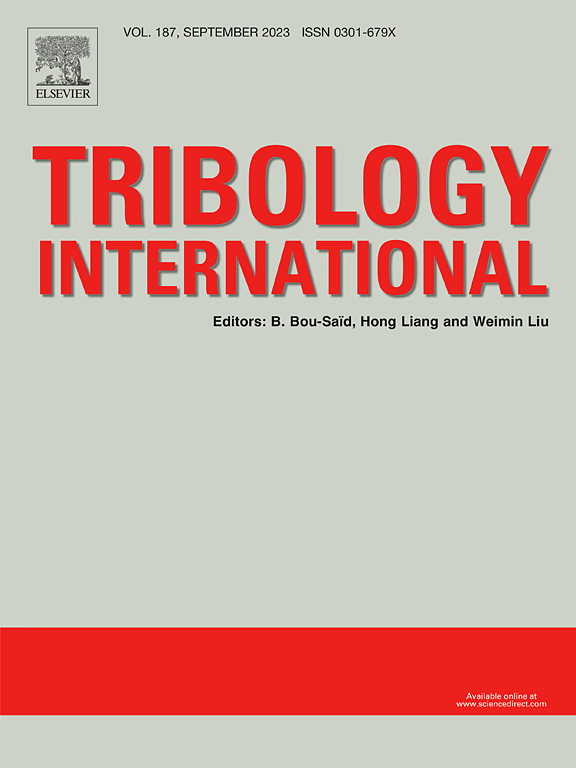基于构型力理论的包容性对风力涡轮机齿轮接触损伤演变的影响
IF 6.1
1区 工程技术
Q1 ENGINEERING, MECHANICAL
引用次数: 0
摘要
风电机组齿轮箱长期承受随机风载荷等复杂环境,齿轮接触疲劳成为制约风电机组设备稳定性和可靠性的关键因素。因此,齿轮接触损伤演化机理的研究面临着复杂应力状态、损伤各向异性和失效建模等难题。然而,传统的断裂力学和损伤力学在预测复杂缺陷的破坏载荷和评估结构完整性方面存在局限性。材料构型力理论可以描述缺陷构型变化对材料自由能的影响,并用于预测材料的损伤和失效行为。本文基于该理论构建了风力涡轮机齿轮接触损伤模型。针对齿轮接触的关键承载区域进行了齿轮接触界面应力场模拟分析,模拟了接触载荷作用下齿轮接触损伤的演变过程。针对金属氧化物夹杂导致的齿轮失效问题,建立了基于 Jk 参数的损伤演化模型。对含有夹杂物的齿轮在接触载荷下的损伤演化过程进行了数值模拟,分析了夹杂物的深度、形状和位置对损伤演化行为的影响。研究结果表明,构力理论损伤模型能有效模拟齿轮的接触损伤现象,解释齿轮表面的点蚀和剥落。这对准确预测齿轮的接触疲劳寿命具有重要的理论意义。本文章由计算机程序翻译,如有差异,请以英文原文为准。
Effect of inclusion on contact damage evolution of wind turbine gears based on configurational force theory
The gear box of wind turbine is subjected to the complex environment such as random wind load for a long time, and the gear contact fatigue becomes a key factor limiting the stability and reliability of wind turbine equipment. Therefore, the research on the gear contact damage evolution mechanism is faced with difficulties such as complex stress states, damage anisotropy and failure modeling. However, traditional fracture mechanics and damage mechanics are limited in predicting the failure load of complex defects and evaluating the structural integrity. Material configurational force theory can describe the effect of defect configurational change on the free energy of materials and be used to predict the damage and failure behavior of materials. In this paper, a wind turbine gear contact damage model is constructed based on this theory. The gear contact interface stress field simulation analysis is carried out for the key bearing area of gear contact, and the gear contact damage evolution process under contact load is simulated. For the problem of gear failure caused by metal oxide inclusion, the damage evolution model based on Jk parameters is established. The damage evolution process of gear containing inclusions under contact loading is simulated numerically, and the influence of depth, shape and location of inclusions on the damage evolution behavior is analyzed. The research results have shown that the configurational force theory damage model can effectively simulate the contact damage phenomenon of gear and explain the pitting and spalling of gear surfaces. It has theoretical significance to predict contact fatigue life of gear accurately.
求助全文
通过发布文献求助,成功后即可免费获取论文全文。
去求助
来源期刊

Tribology International
工程技术-工程:机械
CiteScore
10.10
自引率
16.10%
发文量
627
审稿时长
35 days
期刊介绍:
Tribology is the science of rubbing surfaces and contributes to every facet of our everyday life, from live cell friction to engine lubrication and seismology. As such tribology is truly multidisciplinary and this extraordinary breadth of scientific interest is reflected in the scope of Tribology International.
Tribology International seeks to publish original research papers of the highest scientific quality to provide an archival resource for scientists from all backgrounds. Written contributions are invited reporting experimental and modelling studies both in established areas of tribology and emerging fields. Scientific topics include the physics or chemistry of tribo-surfaces, bio-tribology, surface engineering and materials, contact mechanics, nano-tribology, lubricants and hydrodynamic lubrication.
 求助内容:
求助内容: 应助结果提醒方式:
应助结果提醒方式:


